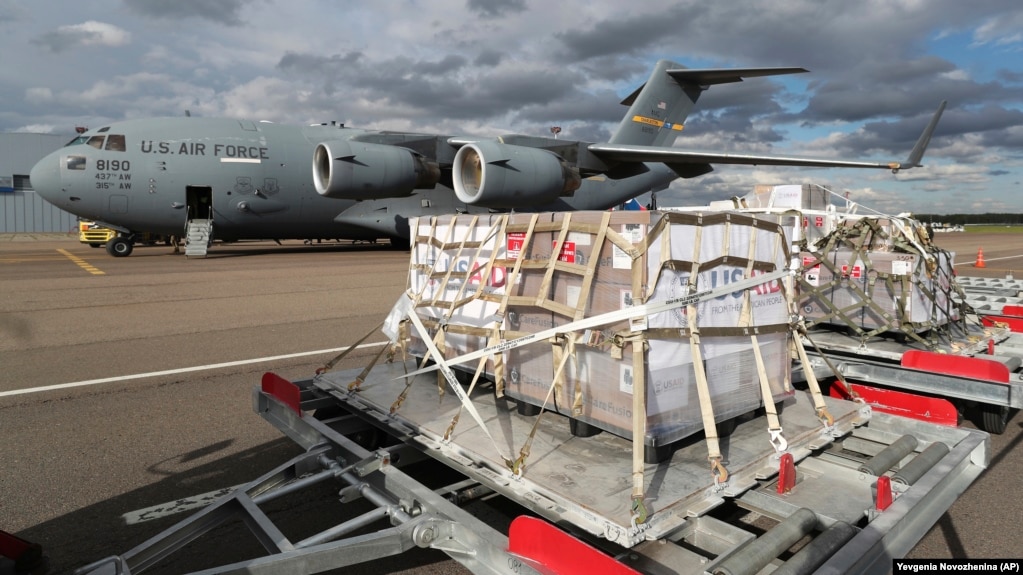
Radio Free Europe / Radio Liberty
Second Shipment Of U.S. Ventilators Heading To Russia Amid Continuing Questions
by Mike EckelA second shipment of U.S.-built ventilators will head to Moscow to help Russia in its fight against the coronavirus, a goodwill gesture by U.S. President Donald Trump’s administration that has been trailed by questions and criticism.
The shipment is scheduled to arrive in Moscow on May 30, two days after congressional Democrats released a second letter demanding more information about an earlier shipment of Russian-built ventilators that were sent to the United States.
That shipment has been clouded by questions over who exactly paid for it, whether the Trump administration knew that Russian companies sanctioned by the U.S. Treasury Department might have been involved, and whether the Russian ventilators were even safe to use at all.
A spokesman for Vyaire Medical, a Chicago-based medical-supply company, told RFE/RL that 150 of the company’s ventilators were scheduled to arrive in Russia on May 30, adding to the 50 that were shipped there earlier this month by the U.S. aid agency, USAID.
Patrick O’Connor gave no further details and did not immediately respond to a follow-up query on the overall costs or other logistics of the shipment.
An earlier shipment of 50 ventilators arrived in Moscow on a U.S. military cargo plane on May 21, a delivery described by the U.S. Embassy as a “humanitarian donation.”


SEE ALSO:
U.S. Says Military Plane With Ventilator Shipment Arrives In Moscow
U.S. officials said the entire cost of the 200 ventilators was around $5.6 million and that the United States was paying “100 percent of the cost, delivery, and start-up supplies.”
“The United States and Russia have helped each other in times of crisis in the past and will no doubt do so again in the future,” the U.S. Embassy said at the time.
There was no immediate comment from Russia on the new shipment.
Russia ranks third in the world for confirmed cases of the coronavirus as of May 29, though its death toll has been unusually low, prompting questions from critics who say officials are purposely undercounting fatalities.
The two U.S. shipments came weeks after Russia sent Russian-built ventilators and other medical supplies to the United States, following a conversation between Trump and Russian leader Vladimir Putin in late March.
The Russian shipment, which included 45 ventilators, was initially dogged by questions and confusion over who exactly paid for it, and then later over the involvement of two Russian companies who appeared to fall under U.S. Treasury Department sanctions.


SEE ALSO:
The Strange Story Of A Russian Ventilator Shipment To The U.S. Just Got Stranger
The State Department later announced the ventilators had been purchased, not donated, and that Russia had billed the United States nearly $660,000 for the goods. The Treasury Department told RFE/RL the exporter did not appear to fall under U.S. sanctions.
Weeks after their arrival, news emerged that the ventilators, which had been earmarked for New York City regional hospitals, had never been used and returned to the Federal Emergency Management Agency “out of an abundance of caution.”
In Russia, meanwhile, regulators ordered a nationwide suspension on use of the ventilators after two deadly fires at medical facilities in St. Petersburg and the Moscow region were blamed on the devices.
The U.S. shipment of ventilators prompted criticism from a group of congressional Democrats, who asserted that the United States was still suffering from a shortage of ventilators. The United States has the world’s most confirmed cases of coronavirus and the world’s highest death toll.
The lawmakers also alleged the shipment was more intended by the Trump administration to curry favor with the Kremlin.
In a second letter dated May 28, congressional Democrats demanded more information about the Russian shipment to the United States, asserting that “misguided decisions” had wasted “millions of U.S. taxpayer dollars, undermine[d] our foreign policy and national security interests, and impair[ed] our nation’s ability to combat the coronavirus crisis.”
The U.S. shipment is part of what U.S. officials have trumpeted as a $10 billion effort to help countries fight the coronavirus. South Africa, for example, is reportedly receiving 1,000 U.S.-built ventilators.
According to Vyaire’s website, the company in April received a $407 million U.S. government contract to produce 22,000 similar ventilator models.